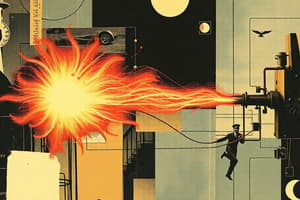Podcast
Questions and Answers
In physics, work is defined as the product of:
In physics, work is defined as the product of:
- Force and displacement (correct)
- Mass and velocity
- Force and time
- Energy and power
Which of the following represents a scenario where work is positive?
Which of the following represents a scenario where work is positive?
- Holding a heavy box stationary
- Friction slowing down a moving box
- Pushing a box across a smooth floor (correct)
- Lowering a heavy box to the ground
When is work considered negative?
When is work considered negative?
- When the force and displacement are in the same direction
- When the force and displacement are perpendicular
- When there is no displacement
- When the force and displacement are in opposite directions (correct)
In which scenario is the work done equal to zero?
In which scenario is the work done equal to zero?
What type of quantity is work?
What type of quantity is work?
What unit is work measured in?
What unit is work measured in?
The formula for work is given by:
The formula for work is given by:
If the angle between the force and displacement is 0 degrees, the work done is:
If the angle between the force and displacement is 0 degrees, the work done is:
What does the dot product of two vectors result in?
What does the dot product of two vectors result in?
In the context of physics, "work" refers to:
In the context of physics, "work" refers to:
Which of the following angles between the force and displacement will result in negative work?
Which of the following angles between the force and displacement will result in negative work?
What is the first step in calculating work according to the provided method?
What is the first step in calculating work according to the provided method?
Which of the following activities is an example of zero work being done?
Which of the following activities is an example of zero work being done?
In the work formula $W = F \cdot d \cdot cos(\theta)$, what does $\theta$ represent?
In the work formula $W = F \cdot d \cdot cos(\theta)$, what does $\theta$ represent?
Flashcards
Definition of Work (Physics)
Definition of Work (Physics)
The product of an external force on an object and the displacement caused by the force. Measures energy transferred in or out of an object.
Positive Work
Positive Work
Work is positive when the external force and the object's displacement are in the same direction.
Negative Work
Negative Work
Work is negative when the external force and the object's displacement are in opposite directions.
Zero Work
Zero Work
Signup and view all the flashcards
Work (in Physics)
Work (in Physics)
Signup and view all the flashcards
Work (General)
Work (General)
Signup and view all the flashcards
Work Formula
Work Formula
Signup and view all the flashcards
Positive Work Angle
Positive Work Angle
Signup and view all the flashcards
Negative Work Angle
Negative Work Angle
Signup and view all the flashcards
Zero Work Angle
Zero Work Angle
Signup and view all the flashcards
Newton's Second Law
Newton's Second Law
Signup and view all the flashcards
Gravitational Force
Gravitational Force
Signup and view all the flashcards
Frictional Force
Frictional Force
Signup and view all the flashcards
Study Notes
- Work is the product of an external force on an object and the resulting displacement.
- It measures energy transferring in or out of an object.
- Work can be positive, negative, or zero.
Positive Work
- Occurs when the external force and the object's displacement are in the same direction.
- Examples include pushing an object on a smooth horizontal surface, riding a bicycle, kicking a stationary ball, and throwing a stone forward into a pond.
Negative Work
- Occurs when the external force and the object's displacement are in opposite directions.
- Examples include throwing an object in the air (gravity acts downwards), fluid resistance (viscosity), pushing an object on a rough surface (friction), and kicking a ball in motion.
Zero Work
- Occurs when the external force or the object's displacement is zero, or when they are perpendicular.
- Examples include carrying a box, pushing a sturdy wall, and sitting on a chair.
What is Work?
- In physics, work is quantitative, defining energy transferred when an object is displaced by an external force.
- In general usage, "work" is non-quantitative, referring to any activity involving physical or mental strain.
Work Formula
-
Work (W) is a scalar quantity, the dot product of force and displacement vectors:
-
W is measured in Joules (J), equivalent to Newton-meters (Nm).
-
is the force vector in Newtons (N).
-
is the displacement vector in meters (m).
-
The dot product results in a scalar quantity.
-
Work indicates the magnitude of energy for displacement, remaining constant even if the coordinate system is rotated.
Angle and Work
- If the angle between the vectors is , work is positive.
- If the angle between the vectors is , work is negative.
- If the angle between the vectors is , work is zero.
- is used in dot products.
Calculating Work
- Determine the directions of force and displacement vectors, using a free-body diagram.
- Determine displacement.
- Determine the force acting on the object using Newton's second law:
- An object's acceleration depends on mass and applied force.
Positive Work Example
- A 2 kg ball drops 1.5 m. The angle between force and displacement is 0 degrees.
- The force acting on the ball is gravitational force = mg = 2 kg * 9.8 m/s² = 19.6 N.
- Work done = 19.6 N * 1.5 m * cos(0) = 29.4 J.
Negative Work Example
- Frictional force of 12 N acts on a box displaced 3 m.
- The angle between force and displacement is 180 degrees.
- Work done = 12 N * 3 m * cos(180) = -36 J.
Zero Work Example
- A 0.5 kg chocolate box is in a trolley moving at 12 m/s.
- The force (weight) acts vertically, and displacement is horizontal.
- The angle between force and displacement is 90 degrees.
- Work done = 0.5 kg * 9.8 m/s² * displacement * cos(90) = 0 J.
Studying That Suits You
Use AI to generate personalized quizzes and flashcards to suit your learning preferences.




